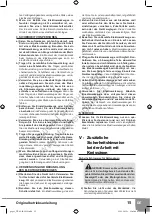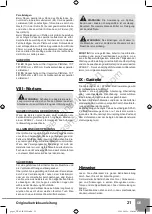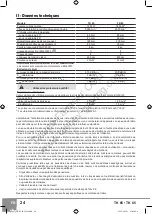
9
Original instructions
EN
2. Adjust the bevel angle of cut as required.
3. Position the saw on the work piece with the front
edge of the base plate resting on the work piece.
Ensure the blade is not touching the work piece.
4. Switch the laser light on by depressing the laser light
switch (4).
5. Line up the laser light with the cutting line on the
work piece.
6. Turn on the motor. Allow the motor to reach maxi-
mum speed before starting the cut.
7. Push the saw forward slowly using both hands with
-
out forcing it through the work piece while keeping
the laser guide on the cutting line.
8. When the cut has been completed, release the on/
off switch and wait for the blade to come to a com-
plete stop.
9. Switch the laser light off by depressing the laser light
switch (4).
10. Remove the saw from the work piece.
CUTTING
Always hold the back handle (23) with one hand and the
front handle (7) with the other hand.
WARNING:
After switching off the saw, be
aware of the necessary time it takes for the blade to
come to a complete stop during coast down. Do not
allow the saw to brush against your body, since the
blade guard (15) is retractable, it could catch on your
clothing and expose the blade (19).
WARNING:
Always make sure either hand
does not interfere with the free movement of the lower
blade guard (15).
When cutting is interrupted, to resume cutting, depress
the lock-off button (2), squeeze the ON/OFF switch (1)
and allow the blade (19) to reach full speed, re-enter the
cut slowly and resume cutting.
When cutting across the grain, the fibres of the wood
have a tendency to tear and lift. Advancing the saw slow-
ly minimizes this effect.
Fig. 5
shows the appropriate position for the user. Posi-
tion your body to either side of the blade, but not in line
with the blade as kickback could cause the saw to jump
backwards.
Cutting Large Sheets
Large sheets and long boards sag or bend, depending
on support. If you attempt to cut without levelling and
properly supporting the piece, the blade will tend to bind,
causing kickback and extra load on the motor.
Use timber underneath the sheet or board to raise it for
support. This will ensure a safe and stable cutting opera-
tion. Support the panel or board close to the cut. Be sure
to set the depth of the cut so that you cut through the
sheet or board only and not the table or work bench. If
the sheet or board to be cut is too large for a table or work
bench, use supporting timbers on the floor and secure.
Rip cuts
The rip fence (24) is used when cutting parallel to the
edge of a shaped part. To attach rip fence (24), insert rip
fence (24) through rip fence slots (11) in base plate (14)
to desired width and secure with the rip fence lock knob
(12).
(Fig. 6)
When rip cutting large sheets, the rip fence (24) may not
allow the desired width of cut. Clamp or nail a straight
piece of 25mm thick timber to the sheet as a guide. Use
the right side of the base plate (14) against the board
guide.
ACCESSORIES
TK 65:
Carbide-tipped blade TCT 36T Ø185 mm x Ø20
mm, hex key, rip fence.
TK 85:
Carbide-tipped blade TCT 48T Ø235 mm x Ø25
mm, spanner, rip fence.
VIII - Maintenance
WARNING:
Always ensure that the tool is
switched off and unplugged before attempting to perform
inspection or maintenance.
BRUSH REPLACEMENT
When the carbon brushes are worn out both brushes
must be replaced simultaneously with genuine brushes
at SPARKY service centre for warranty and post-war-
ranty service.
GENERAL INSPECTION
Regularly inspect all fasteners and ensure they are prop-
erly tightened. Should any of the screws be loose, re-
tighten it immediately to avoid hazards.
If the replacement of the supply cord is necessary, this
has to be done by the manufacturer or his agent in order
to avoid a safety hazard.
CLEANING
For safe operation always keep the machine and its ven
-
tilation slots clean.
Regularly check to see if any dust or foreign matter has
entered the ventilation slots and the grills around the
switches. Use a soft brush and/or air jet to remove any
accumulated dust. Wear safety glasses to protect your
eyes whilst cleaning.
Exterior plastic parts may be cleaned with a damp cloth
and mild detergent if necessary.
WARNING:
Never use alcohol, petrol or other
cleaning agent. Never use caustic agents to clean plastic
parts.
WARNING:
Water must never come into contact
with the tool.
pages_TK 65-85-2012.indd 9
22.11.2012 г. 11:41:43 ч.
Та
ше
в
-
Га
лв
ин
г
ОО
Д
www.tashev-galving.com












































